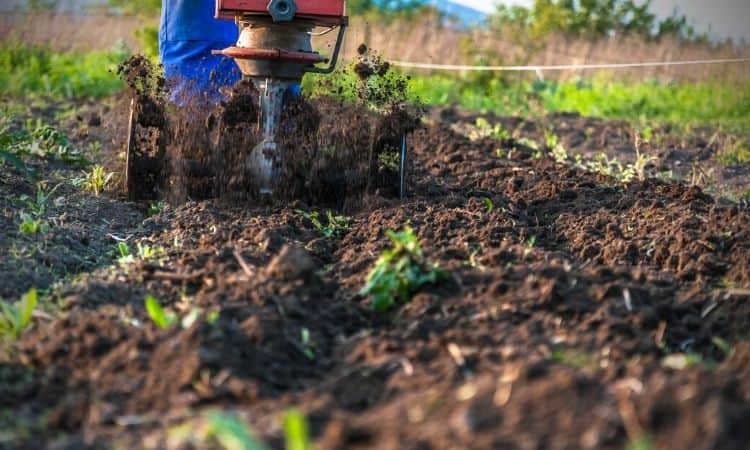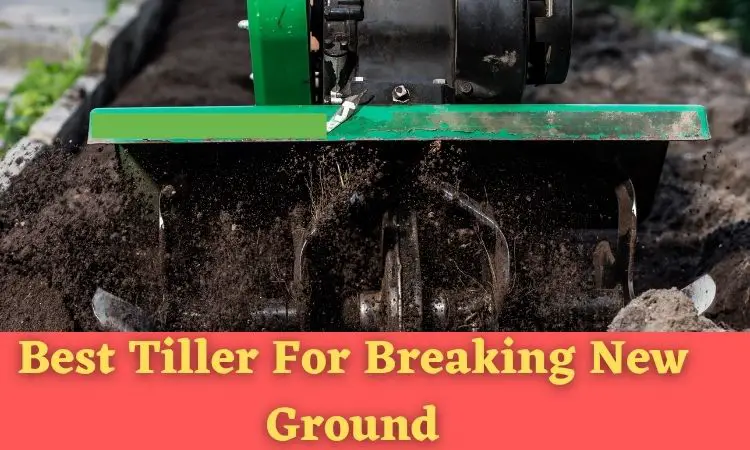To till a small garden without using a tiller, you can manually dig the soil with a garden fork or spade. By turning over the soil in small sections and breaking up clumps, you can effectively prepare your garden for planting.
This method allows for better aeration and drainage of the soil, promoting healthier plant growth. Additionally, you can also use a hoe to break up the top layer of soil and remove any weeds or grass. With a little bit of effort and patience, you can successfully till your small garden without the need for a mechanical tiller.

Credit: gardentherapy.ca
What Are The Key Benefits Of Tilling Without A Tiller?
Tilling is an essential step in preparing the soil for gardening, but it doesn’t have to involve using a tiller. In fact, there are several benefits to tilling a small garden without relying on a mechanical tiller.
Not only can it help reduce costs and save money, but it also helps preserve the soil structure and fertility. Additionally, tilling without a tiller promotes better soil health, leading to healthier plants and more abundant harvests. Let’s explore these benefits in more detail.
Reducing Costs And Saving Money
One of the primary benefits of tilling without a tiller is the potential cost savings. By forgoing the use of a mechanical tiller, you eliminate the need to purchase or rent expensive equipment. Tilling by hand or using alternative methods can be just as effective for small gardens, saving you money in the process.
Moreover, it allows you to allocate those saved funds towards other essential gardening supplies, such as quality seeds, compost, or organic fertilizers that can further enhance your gardening experience.
Preserving Soil Structure And Fertility
Another advantage of tilling without a tiller is the ability to preserve the soil structure and fertility. Traditional tilling with machinery can disrupt the natural composition of the soil, leading to an imbalance in its nutrients and structure.
This disruption can result in compacted soil, increased erosion risks, and reduced water absorption capacity. However, when you opt for manual tilling or alternative techniques like lasagna gardening or no-till gardening, you can maintain the integrity of the soil while improving its structure.
This preservation of natural soil composition helps provide a healthy habitat for beneficial organisms such as earthworms and microorganisms, contributing to long-term soil fertility and sustainability.
Promoting Better Soil Health
Tilling without a tiller also promotes better soil health overall. When the soil structure remains intact, it allows for better aeration, drainage, and root penetration. The absence of machinery reduces soil compaction, allowing plant roots to spread more freely, access essential nutrients, and establish a stronger foundation.
Better soil health leads to healthier plants, increased resistance to pests and diseases, and improved crop yields. Furthermore, preserving the soil’s natural structure and fertility helps retain moisture, reducing the need for excessive watering and improving water efficiency.
Now that we understand the benefits of tilling without a tiller, it’s clear that there are several advantages to exploring alternative methods for small gardeners.
Not only can it save money, but it also helps preserve soil structure and fertility while promoting better soil health. By embracing these approaches, you can create a thriving garden that sustains itself naturally for years to come.
Does Tilling Without Tiller enhance Soil Conditions?
Assessing the soil conditions is a crucial step for successful gardening. Before tilling a small garden without a tiller, it’s important to understand the current state of your soil. This will help you determine any necessary amendments and ensure optimal growing conditions for your plants.
Testing The Soil For Composition And Ph. Levels
Testing the soil composition and pH levels is essential to determine its fertility and acidity. By knowing the current nutrient levels and pH balance, you can make informed decisions about the appropriate amendments. Here’s how you can test your soil composition and pH levels:
- Collect soil samples from different areas of your garden using a soil sampler or gardening trowel.
- Place each sample in a separate container and remove any organic matter or debris from the soil.
- Take a small portion of each sample and place it in a clean glass jar.
- Add distilled water to the jar, filling it about halfway.
- Shake the jar vigorously for a few minutes to allow the soil particles to separate.
- Let the jar sit undisturbed for a couple of hours to allow the soil particles to settle.
- Observe the different layers that have formed in the jar. These layers represent the soil composition, with sand settling at the bottom, silt in the middle, and clay at the top.
- Use a soil testing kit or take the soil samples to a local cooperative extension office for a comprehensive analysis of the nutrient levels and pH balance.
Identifying Any Compaction Or Drainage Issues
Compacted soil can hinder root growth and prevent plants from accessing essential nutrients and water. Similarly, poor drainage can lead to waterlogged soil, suffocating the roots and causing root rot. It’s important to identify any compaction or drainage issues in your garden before tilling the soil. Here’s how you can identify these issues:
- Visually inspect the garden for areas with heavily compacted soil. These areas may appear hard or crusted.
- Use a garden fork or spade to check the soil’s resistance to penetration. If it’s difficult to insert the tool into the soil or if you encounter resistance, it indicates compaction.
- Look for areas with standing water or slow water drainage after rainfall. These indicate poor drainage and possible waterlogging issues.
- Take note of any plants that appear stunted or show signs of water stress, as these could be indications of underlying compaction or drainage problems.

Understanding The Specific Needs Of Your Plants
Every plant has specific requirements regarding soil type, pH levels, and nutrient availability. Understanding these needs will help you determine the necessary amendments and ensure your plants thrive in your garden. Here’s how you can assess the specific needs of your plants:
Research the optimal conditions for each plant variety you intend to grow. This information is usually available on seed packets or online gardening resources.
Consider the soil composition, pH levels, and nutrient requirements mentioned for each plant. Check if the current soil conditions align with the recommended conditions for each plant.
Identify any discrepancies and plan the necessary amendments to meet your plants’ specific needs. Keep in mind that certain plants may have contrasting requirements, so it’s important to group them accordingly.
How To Prepare For Tilling Without A Tiller? ( Techniques )
Using Double Digging For Deep Soil Preparation
Double digging is a powerful technique for preparing the soil in your small garden without the use of a tiller. It involves manually loosening the soil to a greater depth, allowing the roots of plants to penetrate deeper and access essential nutrients. To double-dig, follow these steps:
- Start by removing any weeds or debris from the designated area.
- Using a spade or a garden fork, dig a trench along the length of your garden bed, about 12 to 18 inches wide and 12 inches deep.
- Place the excavated soil from the first trench into a wheelbarrow or another designated area nearby.
- Continue digging adjacent trenches, incorporating the soil from the previous trench into the next one. This process ensures a thorough mixing and aeration of the soil.
- Once you reach the end of the bed, fill in the final trench with the soil that was originally excavated from the first trench, creating a raised bed effect.
Implementing Raised Bed Gardening For Improved Drainage
Raised bed gardening is an excellent method to till your small garden without a tiller while providing improved drainage. It prevents soil compaction, allows for better root growth, and facilitates easy weeding. Here’s how you can implement raised bed gardening:
Clear the area where you intend to create the raised bed of any obstacles such as weeds, rocks, or debris. Measure and mark the desired dimensions for your raised bed using stakes or markers.
Using a spade or garden fork, loosen the soil within the marked area to a depth of about 6 to 8 inches. Build the raised bed structure using materials such as wood, bricks, or concrete blocks.
Fill the raised bed with a mixture of organic compost, topsoil, and any other amendments necessary for your specific plant requirements.
Ensure the soil is evenly distributed and level within the raised bed structure.
Incorporating Organic Matter To Enhance Soil Fertility
Incorporating organic matter into your soil is vital for enhancing its fertility, moisture retention, and overall plant health. By following these steps, you can improve soil quality without relying on a tiller:
Identify sources of organic matter such as compost, well-rotted manure, leaf mold, or grass clippings.
Spread a layer of the organic matter over the surface of your garden bed, approximately 2 to 3 inches thick.
Using a garden fork or rake, gently work the organic matter into the top few inches of the soil.
Repeat this process annually or as needed to maintain optimal soil fertility.
Manual Tools For Tilling Without A Tiller
Tilling is an essential step in preparing your garden for planting. While many gardeners rely on tillers for this task, not everyone has access to or wants to use a bulky machine. Fortunately, several manual tools can help you till your small garden without a tiller.
Using A Garden Fork To Loosen Compacted Soil
A garden fork is a versatile tool that can be used for many gardening tasks, including tilling. Its sturdy tines are designed to penetrate the soil and break up clumps, allowing air and water to reach the roots of your plants more easily.
To use a garden fork for tilling, start by removing any large rocks or debris from the soil surface. Then, insert the fork into the soil, angling it slightly backward to prevent excessive strain on your arms and back.
Apply pressure to the handle to penetrate the soil and lift the fork upward, breaking up the compacted soil. Repeat this process across the entire garden, covering all areas that need tilling.
Utilizing A Broadfork For Deeper Soil Aeration
A broad fork is another excellent manual tool for tilling without a tiller. This tool has long, sharp tines that penetrate the soil deeply, allowing for effective aeration and loosening of compacted soil layers. Utilizing a broad fork can improve soil structure, enhance root penetration, and promote overall plant health.
To use a broad fork, position yourself behind the tool, grasp the handles firmly, and step onto the crossbar with your body weight centered. Insert the tines into the soil by using downward pressure and a rocking motion.
Once the tines are fully inserted, lean back to lift and loosen the soil. Continue this process, spacing your insertions evenly, until the entire area is tilled.
The Benefits Of A Hand Tiller Or Cultivator
A hand tiller or cultivator is a compact and lightweight tool specifically designed for tilling small areas. It features rotating blades or tines that easily penetrate the soil, making it an efficient option for breaking up clumps and preparing the ground for planting.
Using a hand tiller or cultivator is simple. Grip the tool firmly and position it at the desired spot in the garden. Apply downward pressure and simultaneously rotate or push the blades into the soil. Move the tool in a back-and-forth motion while maintaining steady pressure, ensuring you cover the entire area that needs tilling.
By utilizing these manual tools – the garden fork, broad fork, and hand tiller or cultivator – you can efficiently till your small garden without the need for a bulky tiller. Experiment with each tool to find the one that suits your needs and enjoy the process of preparing your garden for your favorite plants and vegetables.
Alternative Methods For Tilling Without A Tiller
When it comes to preparing a small garden for planting, there are alternative methods that can be used to achieve the desired results without a tiller. These methods focus on low-maintenance soil preparation, maximizing the benefits of organic mulch and cover crops, as well as reducing soil disruption through crop rotation and companion planting.
Sheet Mulching And Lasagna Gardening For Low-maintenance Soil Preparation
Sheet mulching and lasagna gardening are excellent alternatives to tilling that can help you prepare your small garden for planting with minimal effort. These methods involve layering organic materials directly onto the soil surface, creating a nutrient-rich environment that promotes healthy plant growth.
With sheet mulching, start by mowing or cutting down any existing vegetation in your garden. Then, lay down a layer of cardboard or newspaper over the entire area, ensuring there are no gaps. This acts as a weed barrier and helps to smother any existing vegetation.
On top of the cardboard or newspaper, add layers of organic materials such as grass clippings, leaves, compost, and straw. The layers should be at least 6 to 8 inches thick. Over time, these materials will break down, enriching the soil and creating a fertile planting bed.
Lasagna gardening follows a similar principle but involves layering organic materials in a specific order, resembling the layers of a lasagna.
Start with a layer of newspaper or cardboard as a weed barrier, followed by alternating layers of nitrogen-rich green materials (such as grass clippings and kitchen scraps) and carbon-rich brown materials (such as leaves and straw). Repeat these layers until the desired height is reached. As the layers decompose, they create nutrient-rich soil that’s perfect for planting.
The No-till Approach: Maximizing The Benefits Of Organic Mulch And Cover Crops
The no-till approach is another effective method for tilling a small garden without a tiller. It involves taking advantage of organic mulch and cover crops to improve soil fertility and structure while minimizing soil disruption.
Organic mulch acts as a protective layer over the soil, preventing weed growth, conserving moisture, and regulating soil temperature. It also gradually breaks down, releasing nutrients into the soil and improving its overall health. Apply a layer of organic mulch, such as straw, wood chips, or compost, around your plants to reap these benefits.
Cover crops are plants that are grown specifically to improve the soil. They help control erosion, suppress weeds, add organic matter, and improve soil structure. Planting cover crops in between growing seasons or in unused areas of your garden can provide numerous benefits.
They can be easily incorporated into the soil by cutting them down and leaving the green residue on the surface as a mulch or by tilling them under if necessary.
Implementing Crop Rotation And Companion Planting To Reduce Soil Disruption
Crop rotation and companion planting are techniques that not only reduce soil disruption but also promote plant health, control pests, and improve yields. By strategically planning which crops to plant in different areas of your garden each year, you can break pest and disease cycles, minimize soil nutrient depletion, and maximize productivity.
When it comes to companion planting, certain plants have natural affinities for one another, benefiting their growth when planted together.
For example, planting marigolds alongside vegetables can deter pests, while legumes like beans or peas can fix nitrogen in the soil, benefiting neighboring plants that require this essential nutrient. Research companion planting combinations that work well for the crops you want to grow and incorporate them into your garden layout.
| Crop Rotation Benefits | Companion Planting Benefits |
|---|---|
|
|
By implementing these alternative methods for tilling without a tiller – such as sheet mulching, lasagna gardening, the no-till approach, crop rotation, and companion planting, you can effectively prepare your small garden for planting while minimizing soil disruption and ensuring optimal plant growth. These techniques provide sustainable, low-maintenance solutions that not only benefit your garden but also contribute to a healthier and more eco-friendly approach to gardening.
Frequently Asked Questions On How To Till Small Garden Without Using A Tiller
What Is An Alternative To Tilling?
An alternative to tilling is a no-till gardening method. It involves leaving the soil undisturbed, using organic mulch, and covering crops to improve soil health and prevent weed growth.
How Do You Till Soil For A Vegetable Garden By Hand?
Tilling soil for a vegetable garden by hand is easy. Start by removing weeds and rocks. Use a spade or garden fork to loosen the soil. Break up clumps and smooth the surface. Add compost or organic matter to improve fertility.
Finally, water the soil before planting your vegetables.
How Do You Start A Small No-till Garden?
To start a small no-till garden, begin by preparing the soil by removing weeds and loosening it with a garden fork. Then, add compost or organic matter to enrich the soil. Plant your desired seeds or seedlings, making sure to space them properly.
Mulch the garden bed to retain moisture and suppress weeds. Water regularly and keep an eye on pests.
How Can I Till A Small Garden Without Using A Tiller?
You can till a small garden without using a tiller by using alternative methods such as double digging, sheet mulching, or using a manual hoe or fork. These methods help break up the soil and prepare it for planting without the need for mechanical equipment.
Conclusion
Tilling a small garden without a tiller is not only possible but also a cost-effective and eco-friendly option. By employing alternative methods such as double-digging, using a garden fork, or utilizing raised beds, gardeners can achieve the desired soil preparation without relying on heavy machinery.
These techniques ensure the proper aeration and nutrient distribution necessary for healthy plant growth, ultimately leading to a successful garden harvest. So, roll up your sleeves and get ready to cultivate your garden without a tiller.

I am a graduate of Bangladesh Agricultural University, where I delved into various agricultural disciplines, equipping me with a profound understanding of agriculture. Beyond academics, I have hands-on experience in gardening and crop cultivation. My passion is to embrace sustainable farming and horticulture. With a BSc in Agriculture, I am dedicated to promoting environmentally conscious and efficient agrarian practices.
Bachelor of Science (BSc) in Agriculture (Hons.)
Master of Science. (Sustainable Agriculture & Food Security ) (MS)
Bangladesh Agricultural University




